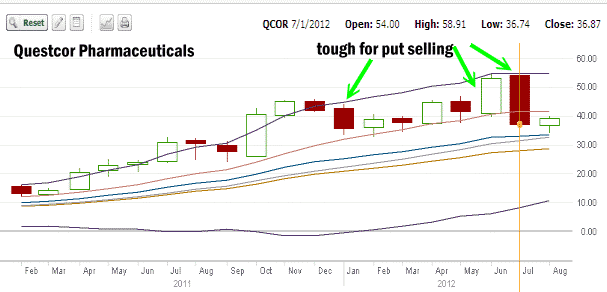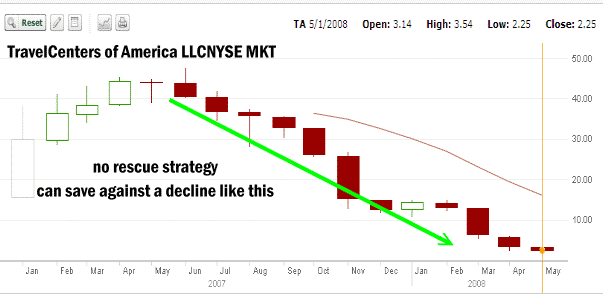Put Selling has been my primary method of investing for over decades. I started Put Selling at a time when only a handful of stocks even had options available for trading. Over the years I am always asked why I stay with blue chip, large cap dividend paying stocks with my Put Selling strategies. Particularly when Junior and Speculative Stocks seem to have much higher option premiums making Put Selling seem more profitable.
When the volatility in the stock market in general, begins to drop off, put options premiums decline along with most option premiums. When this happens investors feel that Junior Stocks and Speculative Stocks offer even better reasons to consider them for Put Selling.
But I have found over the years that my Put Selling strategies continue to consistently perform when I stay with large cap dividend paying stocks. Over the next couple of weeks I plan to post a number of articles discussing my reasons for staying with large cap dividend paying stocks and what I have found after 4 decades of investing.
Put Selling Only Dividend Paying Large Cap Stocks – Reason Number 1
Higher Percentages of Winning Trades
Years ago when I was still developing my Put Selling strategies I found that with Junior Stocks and Speculative Stocks only about 65% of the time the trades ended successfully. The other 35% I either had to close early for small profits or ended up buying to close the put options for losses.
The problem was put selling speculative stocks could return 4% in a month and then be down 15% in a matter of a day. This wiped out months of earnings.
As Put Selling is an investment strategy of earning small option premiums monthly, I was originally thrilled to find that some Junior Stock and Speculative stocks could provide much higher put option premiums. I carefully used support and resistance levels and studied all my stock technical analysis tools and then I would sell puts. I didn’t realize that Junior Stocks can swing in a moment and that stock technical analysis could not predict the volatility associated with a lot of these stocks.
Some months I earned 4% and so I had dreams that I would be earning 40% and 50% a year. I thought this would be fantastic as I could easily double my money every two years. But what I found was I had some great months and then some terrible ones. That 4% a month quickly turned to some months earning nothing and others ending with losses. Suddenly my 40% or 50% annual returns began to look more like 10% to 15% annual returns, which, don’t get me wrong was still good, but it was an incredible amount of work to do Put Selling on the junior stocks or speculative stocks, monitor them constantly and often making adjustments to the Put Selling trades. I paid out a lot of commissions as I had to continually make put selling adjustments, closing some trades for small losses and trying to open new ones.
Put Selling More Than A Handful of Stocks
I also found I was not Put Selling a handful of stocks as I do today. At the outset I tried put selling with just 10 or 15 speculative or Junior stocks, but this ended up with too much money in each trade. Put Selling trades that worked out well, were fine, but trades that ended with losses often were large. I therefore had to reduce the amount of capital associated with each put selling trade which meant loading up on more Junior and speculative stocks.
I felt that $10,000 to a Put Selling trade was enough to risk. This meant that I had more than 50 stocks I was Put Selling against. These all had to be monitored making managing that many stocks extremely difficult. It also increased the odds of losing trades versus winning trades. The amount of time spent investigating Junior Stocks and Speculative Stocks jumped with each stock trade.
Time Wasted
I also found that a Junior Stock or Speculative Stock that performed well in one month, could not be counted on for the next month. I found with many Junior Stocks that volatility which drives up option premiums also meant that often Put Selling could end disastrously, wiping out months of gains. I spent hours scouring through the Junior and Speculative Stocks looking for the next stock to do Put Selling against.
Put Selling Junior Stocks Can Be A Disaster
For example an investor friend that does sell against Junior Stocks provided me with this chart from Questcor Pharmaceuticals (QCOR) which is a member of the Russell 2000 ETF (IWM). These types of stocks are incredibly risky for Put Selling as wide swings are common. As well a junior stock can move from $10 to $60 and back again making it difficult to decide whether to add more puts as a Junior stock falls, to profit from when the stock recovers because many times they did not recover.
Often option premiums that were lucrative for selling, dried up once the stock collapsed.

Put Selling Junior Stocks can be filled with problems if the right stocks are not picked.
Other Junior Stocks can be downright dangerous to a portfolio. Below is the chart from TavelCenters. No amount of rescue strategies can assist a decline like this. The only recourse when a decline commences in many Junior Stocks is to sell at a loss and get out.

Put Selling some Junior Stocks can end in disaster unless carefully monitored
Which Stocks Perform The Best
I also found that I never knew which stocks would perform the best, month after month. I could have 65% of the trades work out, but those 65% might be the trades where I did just .25 cents or .50 cents and the 35% of the trades that failed were the ones where I did .75 cents or $1.00. So, despite 65% of the trades working out I found that when Put Selling, the 35% that didn’t work out often reduced dramatically the profit from the 65% that did work out.
Put Selling Rescue Strategies Failed
I found repeatedly that with Junior Stocks no rescue strategies could be counted on to save a losing position simply because often the Junior Stock itself failed to recover. Many just disappeared from the exchanges. This meant keeping a sharp eye on the naked puts sold and close them early for profits or close them for small losses to avoid larger losses. Many times I closed for a small loss only to watch the stock recover just days later and leave the naked put options once more out of the money.
All of this ate into my expected returns. I no longer was receiving 4% every month in Put Selling income.
The Change To Put Selling Large Cap Stocks
When I changed to large cap dividend paying stocks I noted immediately that 85% of the Put Selling trades were profitable and only 15% ended with either losses or had to be rescued.
I found that consistently I had winning trades and instead of months yo-yo returns, I had steady months of 1% to 3% returns. I found that I never had months with negative losses in my portfolio and I compounded my capital much quicker.
I found that many times the puts that I had sold, could be held until options expiry and allowed to expire.
Using Margin Safely When Put Selling Large Cap Stocks
I found that while many of the Put Selling trades I did on large cap stocks brought in just 1% or 2% in a month, I could use my margin to sell puts safely at further out of the money put strikes to earn 1/2% a month. This meant I was earning an additional 5% a year on my margin and spent very little time worrying about those far out of the money puts ever being assigned. This meant margin was never actually called upon. Therefore while my capital was earning 1% a month or 12% a year, my margin was safely bringing in an additional 5% a year and suddenly I had many years where I was earning 17% annually with little concern about the underlying stocks I was Put Selling against.
Put Selling Rescue Strategies Worked
Once I changed to Put Selling dividend paying large cap stocks I found that my Put Selling rescue strategies worked. I found I could roll naked puts that had been caught in the money, for months to years to avoid assignment and earn additional income.
Put Selling Summary
Today when readers and investors ask me why I do not like Put Selling any stocks other than large cap dividend paying blue chip type stocks I tell them it is because of consistency of winning trades. It is through this consistency that my capital can compound monthly and grow quickly. I would never again go back to Put Selling Junior Stocks or Speculative Stocks because for one thing, I enjoy the free time I now have since I only need to monitor a handful of stocks and yet enjoy at the minimum, 12% returns each year.
View the Put Selling Index for Put Selling strategies
Review An Index of Put Selling Trades On Stocks
I appreciate any comments and opinions. What are your experiences with Put Selling Junior or Speculative Stocks.

